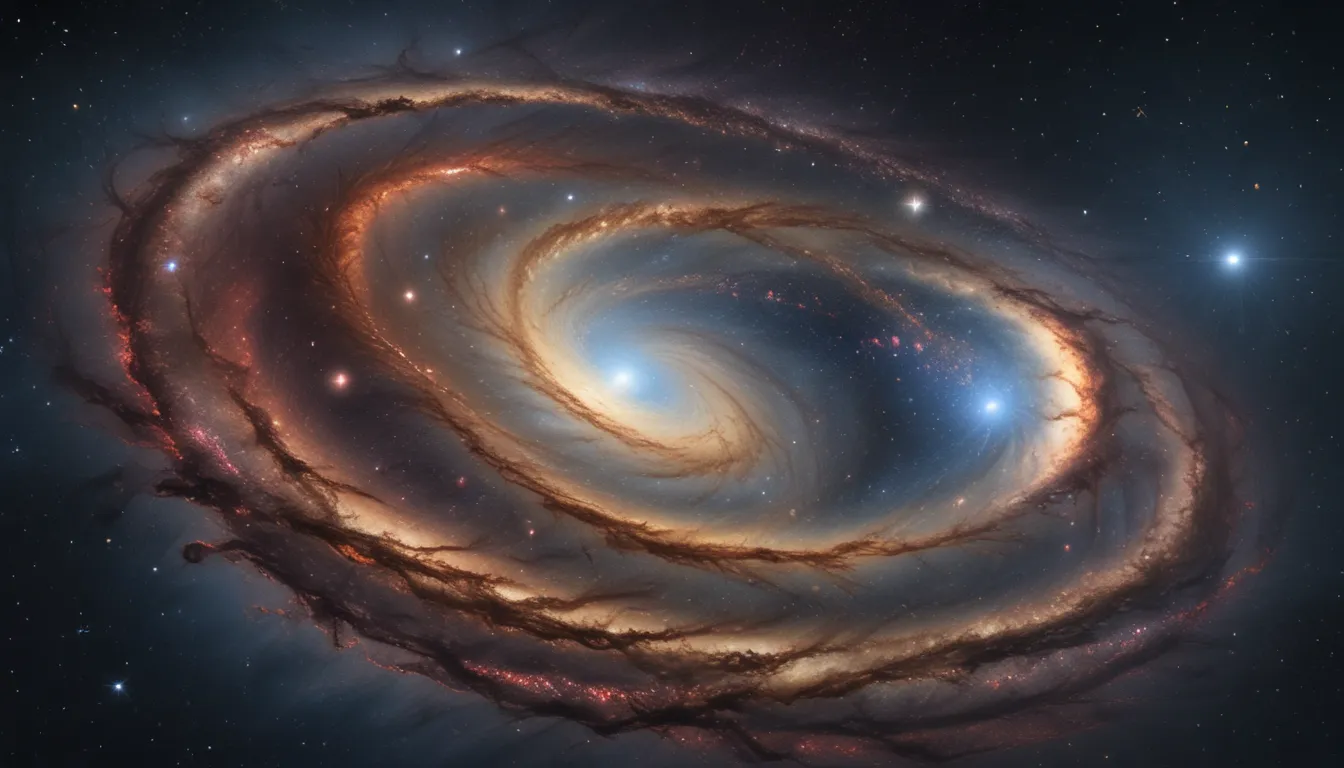The pictures we use in our articles might not show exactly what the words say. We choose these pictures to make you interested in reading more. The pictures work together with the words but don’t take their place. The words still tell you the important facts.
Bode’s Galaxy, known as M81, shines brightly in the constellation Ursa Major, captivating astronomers and stargazers with its mesmerizing beauty and intriguing mysteries. This spiral galaxy, located 12 million light-years away from Earth, boasts a plethora of extraordinary features that make it a striking spectacle in the vast universe.
Delving into the Depths of Bode’s Galaxy
Explore the enchanting realm of Bode’s Galaxy as we uncover 13 extraordinary facts that elevate this celestial wonder to a realm of fascination and awe. From its massive black hole to the possibility of alien life, embark on a journey through the wonders of this distant cosmic phenomenon.
The Majesty of an Ancient Beauty
Behold the majesty of Bode’s Galaxy, a stellar spiral galaxy situated in the Ursa Major constellation, captivating the gaze of amateur astronomers with its breathtaking splendor. This ancient beauty, steeped in history and mystery, beckons us to unravel its secrets.
The Enigmatic Marvel of Stellar Size
Spanning an impressive diameter of approximately 90,000 light-years, M81 boasts billions of stars, including massive blue stars that contribute to its radiant allure. This vast expanse of stellar brilliance mirrors the grandeur of our own Milky Way galaxy, showcasing the celestial magnificence of Bode’s Galaxy.
A Neighborhood of Cosmic Companions
Discover the cosmic neighborhood of M81, the largest galaxy in the M81 group, where it interacts gravitationally with its companion galaxy, M82, shaping each other's destinies over eons. These celestial companions dance in the cosmic ballet of stars, weaving tales of harmony and chaos in the fabric of space.
Supernovae: A Symphony of Celestial Explosions
Witness the spectacle of supernovae within the boundaries of M81, where at least six recorded explosions illuminate the galactic canvas with their fiery brilliance. These cataclysmic events mark the celestial cycles of birth and destruction, shaping the destiny of stars in the cosmic dance of creation.
The Enthralling Saga of an Active Black Hole
Peer into the heart of M81, where a supermassive black hole lurks, captivating the gaze of scientific inquiry with its insatiable appetite for matter and its powerful gravitational pull. This cosmic behemoth, with a mass 70 million times that of our sun, holds the key to unlocking the mysteries of galactic evolution.
A Glimpse into the Past: A Reflection of Millennia
Experience the time-traveling journey of observing M81, where the light that reaches us today embarked on its voyage 12 million years ago, offering a glimpse into the distant past of this awe-inspiring galaxy. Each beam of light carries a message from the depths of time, weaving a tapestry of cosmic history in the night sky.
Halo Stars: Guardians of the Galactic Disk
Marvel at the halo of stars and globular clusters that adorn M81, enveloping its galactic disk in a celestial embrace of stellar splendor. These clusters, teeming with hundreds of thousands of stars, add a touch of elegance to the intricate tapestry of the galaxy, painting a picture of celestial beauty that transcends time and space.
The Symphonic Harmony of Radio Waves
Listen to the cosmic symphony of radio waves emanating from M81, a testament to the intense magnetic fields and celestial processes at play within the galaxy. These ethereal signals weave a web of mystery and intrigue, inviting us to delve deeper into the cosmic orchestra that echoes through the depths of space.
A Celestial Icon for Stargazers
Embrace M81 as a beloved icon in the night sky, cherished by astronomers and stargazers for its mesmerizing spiral arms and intricate structure that offer invaluable insights into the cosmic tapestry of galactic evolution. This celestial gem beckons us to gaze into the depths of the cosmos and marvel at the wonders of our universe.
The Chaotic Beauty of a Galactic Companion
Explore the companion galaxy of M81, M82, a remarkable celestial object undergoing a burst of star formation that ignites stellar winds and colossal plumes of gas and dust. This chaotic beauty adds to the cosmic symphony of M81, creating a tapestry of celestial wonders that captivate the imagination.
The Luminous Splendor of X-ray Emissions
Marvel at the luminous splendor of X-ray emissions emanating from M81, a testament to the myriad X-ray sources within the galaxy, including binary star systems, supernova remnants, and the supermassive black hole at its core. These ethereal signals illuminate the cosmic landscape, revealing the hidden mysteries of the galactic realm.
A Galactic Odyssey: Towards a Collision with Destiny
Witness the cosmic odyssey of M81 as it journeys towards our Local Group of galaxies, with predictions hinting at a potential collision with the Milky Way in about 4 billion years. This celestial dance of galaxies offers a glimpse into the cosmic tides of destiny, shaping the future of these celestial behemoths.
A Platform for Infinite Discoveries
Embark on a voyage of discovery with M81 as your guide, a platform for infinite revelations and cosmic insights into the formation, structure, and cosmic influences that shape the fabric of the universe. Through ongoing observations and technological advancements, scientists continue to unveil the secrets of this celestial marvel, bringing us closer to the mysteries of the cosmos.
Conclusion: A Cosmic Tapestry of Wonder and Beauty
In conclusion, Bode’s Galaxy (M81) stands as a shining beacon of wonder and beauty in the vast expanse of the universe, captivating our hearts and minds with its celestial splendor. Whether you are an experienced astronomer or an enthusiast of cosmic wonders, the exploration of M81 promises to enrich your understanding of the cosmos and leave you in awe of the boundless beauty that surrounds us.
FAQs: Unveiling the Mysteries of Bode’s Galaxy
-
How far away is Bode’s Galaxy (M81) from Earth?
Bode’s Galaxy is located approximately 11.8 million light-years away from Earth. -
What is the size of Bode’s Galaxy?
The diameter of Bode’s Galaxy is estimated to be around 90,000 light-years, slightly smaller than our Milky Way galaxy. -
Can Bode’s Galaxy be seen with the naked eye?
While Bode’s Galaxy is relatively bright compared to other galaxies, it is not visible to the naked eye and requires a telescope or binoculars for observation. -
Does Bode’s Galaxy have any companions?
Yes, Bode’s Galaxy has several companion galaxies, with the most notable being M82, also known as the Cigar Galaxy, often seen in close proximity to M81. -
Are there any notable features or phenomena associated with Bode’s Galaxy?
Bode’s Galaxy is renowned for its active galactic nucleus, housing a supermassive black hole at its center that actively accretes matter and emits powerful radiation, making it a prime target for scientific investigation. -
Can I capture images of Bode’s Galaxy with a regular camera?
While Bode’s Galaxy can be observed and photographed with a standard camera, to capture more detailed images revealing its intricate details, a telescope with a dedicated astrophotography setup is recommended. -
How was Bode’s Galaxy first discovered?
Bode’s Galaxy was first discovered by the German astronomer Johann Elert Bode in December 1774, marking a significant milestone in the exploration of the cosmos. -
Is Bode’s Galaxy part of a larger galaxy cluster?
Yes, Bode’s Galaxy is a member of the M81 Group, a galaxy group that includes other notable objects like M82 and NGC 3077, creating a cosmic tapestry of interconnected galaxies. -
Can I visit Bode’s Galaxy?
While physically visiting Bode’s Galaxy is beyond our reach, the wonders of this celestial marvel can be explored through astronomical observations and images captured by telescopes and space missions, offering a virtual voyage into the depths of the cosmos. -
What makes Bode’s Galaxy extraordinary compared to other galaxies?
Bode’s Galaxy stands out for its proximity to Earth, stunning spiral structure, and active galactic nucleus, combining to create an extraordinary celestial object that inspires scientific curiosity and captivates the imagination with its cosmic beauty.
Embark on a journey through the cosmic splendor of Bode’s Galaxy, a celestial marvel that continues to enthrall and inspire seekers of knowledge and admirers of beauty in the vast expanse of the universe. Dive into the depths of this extraordinary galaxy and uncover the mysteries that lie beyond the stars, weaving a tapestry of wonder and enchantment for all who gaze upon its celestial brilliance.






